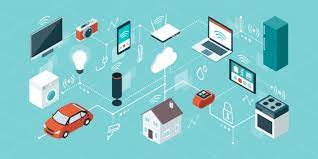IoT hardware components are the physical devices that make up an IoT system. They include microcontrollers, sensors, actuators, and other supporting components. Let’s explore these components in more detail:
- Microcontrollers: Microcontrollers are small programmable devices that serve as the brain of IoT devices. They contain a processor, memory, input/output (I/O) pins, and other peripherals necessary for controlling and interfacing with other hardware components. Microcontrollers are designed for low-power operation and are commonly used in IoT devices due to their compact size, low cost, and energy efficiency.
- Sensors: Sensors are devices that detect and measure physical or environmental conditions. They convert these measurements into electrical signals that can be processed by microcontrollers or other components. IoT sensors come in various types, including:a. Temperature sensors: Measure ambient or object temperature.
+ Humidity sensors: Measure the level of moisture in the air or soil.
+ Proximity sensors: Detect the presence or absence of objects in close proximity.
+ Motion sensors: Detect movement or changes in motion.
+ Light sensors: Measure the intensity or presence of light.
+ Accelerometers: Measure acceleration or changes in velocity.
+ GPS (Global Positioning System) modules: Provide location information.Sensors play a crucial role in collecting data from the physical world and enabling IoT devices to monitor and respond to their surroundings. - Actuators: Actuators are devices that convert electrical signals into physical action or control mechanisms. They enable IoT devices to interact with and affect the physical environment. Some common types of actuators used in IoT systems include:a. Motors: Used for movement, rotation, or mechanical control.
+ Valves: Control the flow of liquids or gases.
+ Solenoids: Generate linear or rotational motion.
+ Relays: Control the switching of electrical circuits.
+ LED lights: Used for visual indication or signaling.Actuators allow IoT devices to perform actions based on data received from sensors or commands received from the network/cloud. - Communication Modules: IoT devices require communication capabilities to connect with other devices or the cloud. Communication modules facilitate wireless or wired connectivity. Examples of communication modules include:a. Wi-Fi modules: Enable devices to connect to Wi-Fi networks for internet connectivity.
b. Bluetooth modules: Support short-range wireless communication between devices.
c. Cellular modules: Provide cellular network connectivity, allowing devices to communicate over long distances.
d. Ethernet modules: Enable wired Ethernet connectivity for IoT devices.Communication modules enable data exchange, remote control, and connectivity with the wider IoT ecosystem. - Power Supply: IoT devices require a power source to operate. Depending on the application and device requirements, power supplies can range from batteries to mains power sources. Power management is crucial in IoT devices to ensure optimal energy efficiency and long battery life.
- Printed Circuit Boards (PCBs): PCBs are used to interconnect and mount various hardware components in IoT devices. They provide a platform for integrating microcontrollers, sensors, actuators, and other components, enabling them to work together effectively.
These are some of the key hardware components used in IoT systems. The selection of components depends on the specific requirements of the IoT application, such as power consumption, cost, size, and environmental conditions. IoT hardware components work in conjunction with software and network infrastructure to create functional and intelligent IoT solutions.
SHARE
